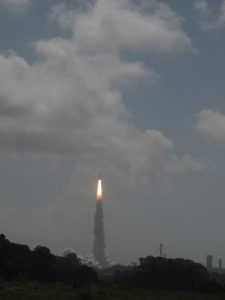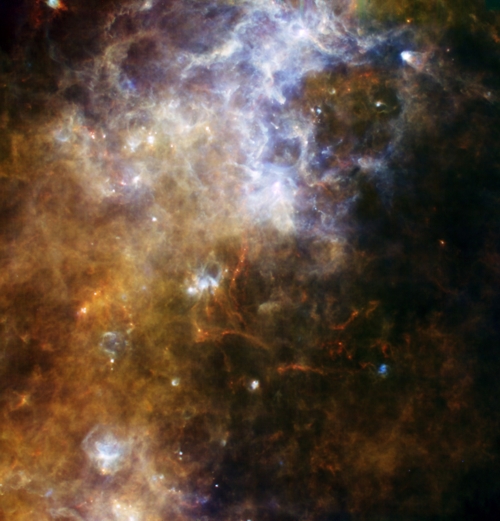
At 13.12 GMT on 14 May 2009, an Ariane 5 rocket carrying two brand new space telescopes launched into space. The two telescopes were Herschel, the largest infrared space telescope ever launched, and Planck, which will make the most sensitive maps of early Universe over the whole sky.
Herschel separated from the upper stages of the rocket about 25 minutes after launch, and has been on its own since then. Just a few days after launch the instruments were checked out, and a few days later the SPIRE instrument became the coldest place in space. Once everything was ready, the commissioning phase began. As well as cooling down some parts of the satellite, commissioning allowed the operations teams the fully understand their satellite and instruments. One month after launch, the final major hurdle was passed, with the opening of the protective cover over the intruments – without that, none of Herschel’s instruments would have been able to see the sky.

The first observations, taken with the PACS instrument of the, showed that the optics were working perfectly, and that all the procedures went as planned, and not long after the SPIRE instrument proved its worth. A few months later, one of the key modes of operations was tested, with the SPIRE and PACS cameras working in unison to obtain spectacular images of the Galaxy.
It wasn’t all plain sailing, though. The HIFI instrument, Herschels high-resolution spectrometer, suffered a major problem when a cosmic ray hit one of the computer chips and caused an unexpected reset. The reset caused a power spike which blew the power supply of a critical component. Luckily, there is a spare on board, and after months of testing HIFI was switched back on. A software update was also applied to ensure that the same problem cannot occur again.
The first few months of the mission after commissioning were dedicated to “Science Demonstration”. As well as proving to themselves that Herschel works as planned, it also allows the Herschel scientists to show the rest of the world what this marvellous observatory can achieve. In early May 2010 a meeting was held at ESA’s technology facility, ESTEC, in the Netherlands to show the forst scientific results from this remarkable observatory. The scientific papers are appearing online at the moment, many of which will be published in a “Herschel Special Issue” of the international scientific journal Astronomy & Astrophysics.
To keep track of the latest results from Herschel, make sure you visit our Results section, where the prettiest images are being showcased. Images are being added regularly, so keep checking back. You can also use our RSS feeds to keep up to date with the latest News and Results.
To celebrate this anniversary, ESA have produced a movie about Herschel’s first year in space. You can watch it below, or view it in higher quality on the ESA website.
